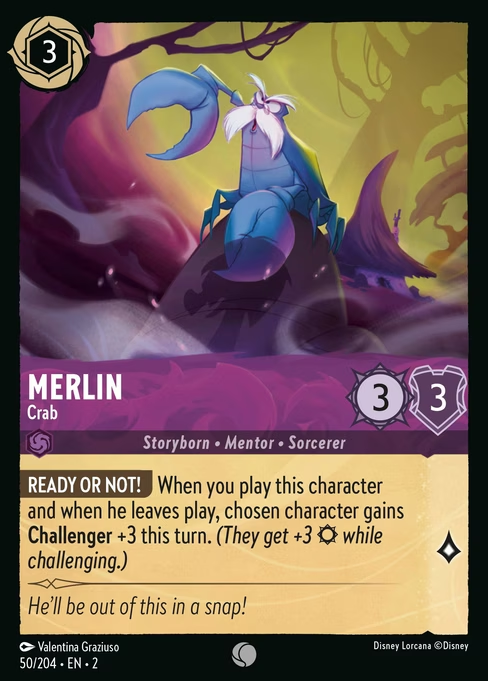There is something exhilarating about watching a plan unfold over multiple turns in Lorcana — where each choice nudges the story toward a well-earned victory. Ruby/Sapphire players have found a captivating duo in Robin Hood – Sharpshooter and Stitch – Experiment 626. Together, they don’t just pressure the board but pull the strings of tempo and recursion in a delicate dance of control and value. With 'Reign of Jafar' enriching the ink pool, this classic pairing is surging again, proving that calculated precision and clever loops can still guide us through the most competitive tables.
Establishing Control with Stitch – Experiment 626
As a 5-cost Ruby character with Rush and an ability that lets him ready after banishing a character in a challenge, Stitch – Experiment 626 welcomes himself into the fray with speed and purpose. He represents a cornerstone of control in Ruby/Sapphire builds, helping to reinforce tempo against fast-starting aggro decks. Players can throw Stitch right into action the turn he arrives, often removing key threats and standing tall again to defend or push further. His synergy with lower-cost action recursion such as Be Prepared or item recycling through cards like Magic Mirror ensures Stitch always has a role, either as a remover or defender. With recent tools from 'Reign of Jafar' adding value to self-reloading strategies, Stitch remains a reliable guardian of the midgame.
Robin Hood – Sharpshooter: The Value Engine
Robin Hood – Sharpshooter offers more than his elegant range. His ability to deal 1 damage to a chosen character each time he quests brings constant utility — softening threats, removing evasive characters, and chipping away at larger foes. As a Sapphire card, his presence in Ruby/Sapphire decks fits seamlessly, encouraging a game plan of incremental advantage. Pairing Robin Hood’s persistence with recursion tools like Belle – Strange but Special or action-reuse enables creative sequencing: damaging a body just enough for Stitch to finish it off efficiently, or setting up for a value trade. That single point of damage, turn after turn, allows you to shape the board with surgical clarity. He doesn’t demand interaction — he dares opponents to respond, and often they can’t afford to.
The Dance of Recursion
Ruby/Sapphire decks thrive on the recursive use of strong actions and characters. Cards like Let the Storm Rage On! or Magic Mirror enhance this identity by letting players reuse effects that deal damage, draw cards, or manipulate the board. With Stitch – Experiment 626 sticking around through multiple challenges and Robin Hood pinging damage while questing, the board becomes your canvas. New additions from 'Reign of Jafar' like The Lamp and Return from Exile provide long-game support by rerouting spent resources into live threats. Whether it’s retrieving key removal actions like Smash or reinvoking board-wide control through recursion loops, the deck rewards patience and planning. Your discard pile is no longer a loss — it is a toolbox.
Tempo Through Synergy, Not Speed
Unlike traditional aggressive decks, Ruby/Sapphire finds its tempo in composure. Stitch – Experiment 626 removes threats while staying active. Robin Hood – Sharpshooter adds pressure while controlling micro-interactions. Together, they generate threats that can’t be ignored without opening space for card draw or stronger board presence. Stitch creates room by aggressively clearing early game bodies while Robin weakens or finishes targets. This alternative tempo style is about interaction — you are always a step ahead, making opponents trade poorly or overextend into recursion traps. Proper sequencing — such as manipulating readiness chains or triggering multiple abilities in succession — defines tempo for this control-driven duo.
A New Chapter in Ruby/Sapphire Deck Identity
With the current meta seeing consistent appearances of this duo at tournament top decks on sites like InkDecks and Lorcana.gg, Robin Hood – Sharpshooter and Stitch – Experiment 626 are redefining what a Ruby/Sapphire control deck can be. They both contribute synergy beyond their stats — Stitch delivers removal and reactive pacing, while Robin ensures efficiency in every board interaction. Players looking to climb must now account for the inevitability these decks present: you may think you’ve cleared them, but recursion brings them back. This evolving identity — call it tempo-control, or board-loop mastery — taps into the essence of deep play and clever planning. Experience, not just ink, determines success here.
Final thoughts
Robin Hood – Sharpshooter and Stitch – Experiment 626 are not just strong characters — they are catalysts for deeper strategies built around recursion and board control in Ruby/Sapphire decks. Their synergy is shaping a new archetype that rewards timing, precision, and clarity of play, allowing Lorcana players to outthink and outlast their opponents with wit rather than brute force.
•




